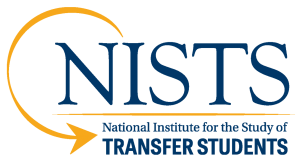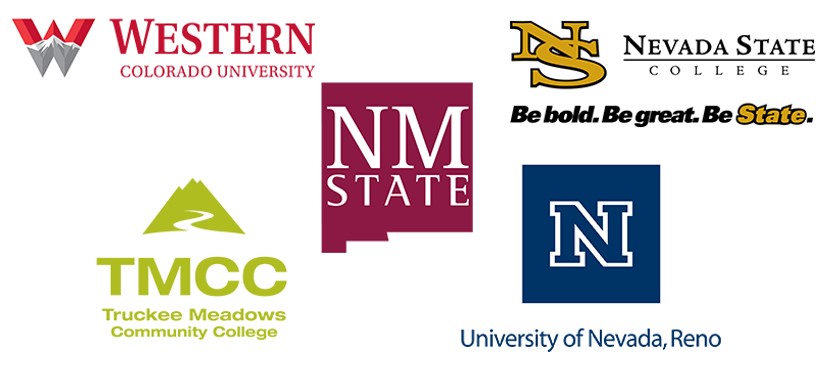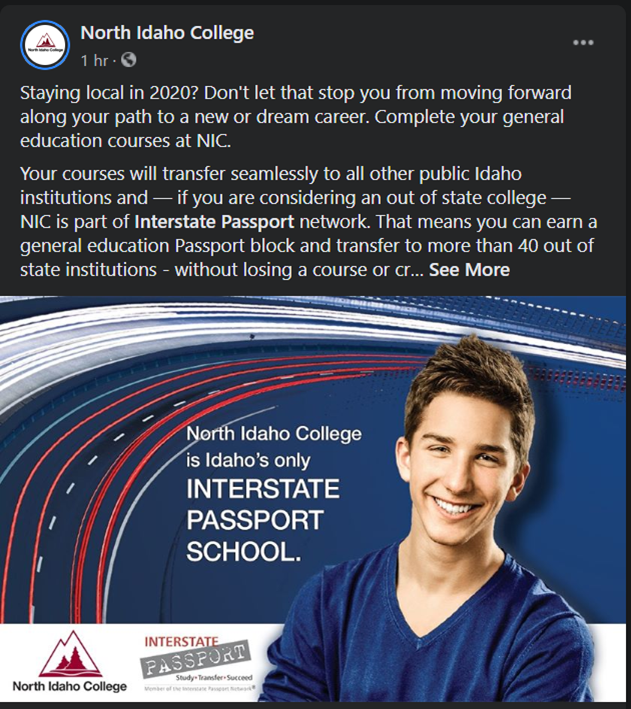As Higher Education Navigates a New Normal, Don’t Let Transfer Students Waste Time and Money
By Laura Couturier and Josh Wyner, Real Clear Policy, June 1, 2020
In the wake of the COVID-19 pandemic, student transfer is in the spotlight like never before. As more students are expected to transfer this year and beyond, the shortcomings of transfer policies and procedures are starkly evident. Students lose credits or may have to repeat coursework, leading to delays in degree attainment and increased costs. The worst consequence is when students drop out altogether. A number of efforts have been made in recent years by states and institutions to remedy the problems of student transfer, including, of course, the Interstate Passport. Even so, the pandemic has exacerbated the effects of uneven transfer practices within and across states.
The authors of this article put forward the case that leadership from the statehouse is necessary and, indeed, essential to a successful transfer plan of action. “An ecosystem that can support the anticipated increase in transfer is far more likely to be built with supportive policy, compelling incentives, and collaborative work at the state level.”
The authors recommend three actions to be taken by state policymakers to accelerate improvements in transfer: (1) clearly declare that transfer students are a priority, (2) provide financial incentives for transfer students and institutions, and (3) assess progress on transfer student success.
The Many Forms of Postsecondary Inequity
New federal data highlight differences in educational outcomes across many individual variables
By Doug Lederman, Inside Higher Ed, August 25, 2020
This article presents findings from a set of studies released by the National Center for Education Statistics that are part of the center’s 2012-17 Beginning Postsecondary Students Longitudinal Study. In particular, the author draws from Six-Year Persistence and Attainment at Any Institution for 2011-12 First-time Postsecondary Students and Six-Year Withdrawal, Stopout and Transfer Rates for 2011-12 First-time Postsecondary Students. The studies show that the gaps between historically underrepresented groups of students — those who are Black and Hispanic, first in their families to go to college, adults or from families with lower incomes and all other students – are persistent and pernicious. Students in these groups were far less likely to earn a degree in six years, and more likely to have left college without a credential. Other factors considered in the study include parents’ college attendance, whether students started college right out of high school or waited a year, whether students worked, and whether students attended continuously.
The direction of transfer also made a difference. “More than half of students who transferred from one four-year institution to another (56.1 percent) earned a bachelor’s degree, compared to 42.7 percent who transferred from a two-year to a four-year institution and 25.2 percent who transferred from a four-year to a two-year college.”
See the Inside Higher Ed article for specific data results: https://www.insidehighered.com/news/2020/08/25/new-federal-data-highlight-differences-educational-outcomes-across-many-variables
The two NCES reports are available here: https://nces.ed.gov/pubs2020/2020238.pdf and https://nces.ed.gov/pubs2020/2020239.pdf
By John Fink, Maria Hesse, Cheryl Hyman, Shirleatha Lee, Sharon Morrissey, and Elena Quiroz-Livanis, Diverse Issues in Higher Education, July 24, 2020
The authors, who are members of the national Tackling Transfer Policy Advisory Board, work to build equitable pathways for students to and through two-year and four-year institutions into careers. They propose four ways to end the transfer swirl and ensure that community colleges serve as an affordable and accessible gateway to higher education that will provide economic mobility to low-income students and students of color.
- Map pathways with career goals in mind: bring employers to the table to understand the skills and knowledge most in demand in the workforce.
- Review and redefine transfer policies: ensure that students can transfer their credits, which doubles their chances of earning a degree.
- Deploy responsive, personalized advising: ensure that students enroll in the right courses in pursuit of their aspirations. States can fund and support advising programs that help students identify their career goals early on.
- Fund innovation: states can provide financial incentives and challenge grants to motivate community colleges and four-year universities to build strong transfer pathways.
A National Snapshot: How Students Experience and Perceive Transferring Earned Credit
By Wendy Kilgore, Steven C. Taylor and Karina Pineda, American Council on Education National Task Force on Transfer of Credit, in collaboration with the American Association of Collegiate Registrars and Admissions Officers, 2020
This comprehensive report presents findings from a recent study by ACE and AACRAO on students’ perceptions about how transfer credit was applied and the potential accumulation of excess credits at graduation. The national study included 1,003 survey completers, with 65 percent of respondents currently enrolled at a public institution and 35 percent at a private institution; 78 percent transferred from a public institution and 22 percent from a private institution. Students were enrolled at institutions in 47 states, the District of Columbia, and Puerto Rico.
Transfer is the first potential point of credit loss for a student. Seventy-seven percent of students had transfer credit evaluations occur automatically; 23 percent of students had to ask the receiving institution to evaluate their transcripts for potential transfer credit. The report presents 12 different factors that are considered in the application of credit earned by a transfer student, all governed by institution policy or practice. For example, 14 percent of institutions do not accept dual enrollment credit. Some institutions limit the number of credits that can be awarded by the course level. Others have curricular policies that impose limits on specific courses that can be awarded in transfer as opposed to being earned at the institution to which the student transferred (e.g., awarding transfer credit for ENG101 but requiring that ENG102 be residential credit).
See Transfer Facts in this newsletter for selected findings from the report.
Highlights from the report summary include:
- More than half of transfer students successfully transfer all credit.
- Among students that were not successful in transferring all credit, most are aware of why the credit did not transfer.
- Most knew credit would be lost in transfer and were not displeased with the outcome.
- Academic advising is an integral part of the transfer funnel, having both positive and negative implications.
- Dual enrollment courses have a role in the credit loss story for almost a third of students who lost credit.
Strong Start to Finish: How Course Pathway Maps Increase Student Success
By Emily Warren, Ed Note, Education Commission of the States, August 11, 2020
Strong Start to Finish is an initiative at the Education Commission of the States that seeks to help higher education institutions increase the number and proportion of low-income students, students of color and returning adults who succeed in college math and English. Course pathway maps provide a visual guide of the links between every class ending with the first college-level (i.e., gateway) math or English course applicable to a degree.
Curricular information collected from six higher education systems produced over 440 individual maps that resulted in three primary takeaways:
- Clear and simple maps help advisors guide students. Course names, sequential course numbering systems, and course descriptions help both students and advisors navigate a pathway to complete a degree requirement in math or English.
- Asset-based course names spur success. Instead of using terms like basic, low-level or remedial to describe developmental education courses, which focus on a lack of skill and can negatively affect students, SSTF recommends using asset-focused language to encourage academic persistence.
- Consistent Definitions Aid Students. Unsurprisingly, the mapping data collected for the project revealed a lack of agreement across institutions on the definition of a gateway course. Consensus across institutions helps students understand degree requirements and can avoid problems with transfer credits.
Essential Practices to Improve Student Transfer: A Call to Action from the Texas Transfer Alliance
By Martha Ellis, University of Texas at Austin, Charles A. Dana Center, June 18, 2020
Formed in late 2018, The Texas Transfer Alliance is a joint effort between the Charles A. Dana Center, the Texas Association of Community Colleges, and four of the state’s public university systems (Texas A&M, Texas State, University of North Texas and the University of Texas). Alliance members seek to collaborate across the state in order to make meaningful progress on transfer student outcomes. In response to the COVID-19 pandemic as well as the national movement toward racial justice, the Alliance has issued a Call to Action to institutions of higher education in the state of Texas, asking colleagues to make transfer a key priority in institutional and COVID-19 response plans. The request asks colleges and universities to create clear pathways for students to transfer successfully with earned credits applied and on track for degree programs, and to provide tailored student services and advising that are responsive to COVID-19 exigencies.
The Texas Transfer Alliance has set ambitious goals to be achieved by 2025, all of which seek to eliminate gaps by race/ethnicity and Pell status: increase four-year bachelor’s completion rate of community college transfers; increase the six-year transfer-out rate; decrease the average number of attempted credits to degree; decrease the average time-to-degree for transfer students, and increase the percent of Texas community college students completing college-level math and writing in the first year.
Transfer Partnerships: Lessons to Improve Student Success During and After COVID-19
by Debra D. Bragg, Lia Wetzstein, Elizabeth Apple Meza, & Theresa Ling Yeh, Data Note 11 / May 2020
This issue of Transfer Partnerships Series – Data Note 11 includes discusses their upcoming release of New Directions for Community Colleges (NDCC) on “Transfer Partnerships for More Equitable Student Outcomes” (Volume 192) and the lessons learned from their research on transfer partnerships and equitable student outcomes. IN particular how two- and four-year institutions coordinated their actions to improve transfer policies and practices, especially for underserved populations. The authors note that transfer partnerships are an important way to battle the racial transfer gap as well as help address the new pandemic realities: “swirling” between colleges, food and housing insecurity, and affordability and equity gaps.








